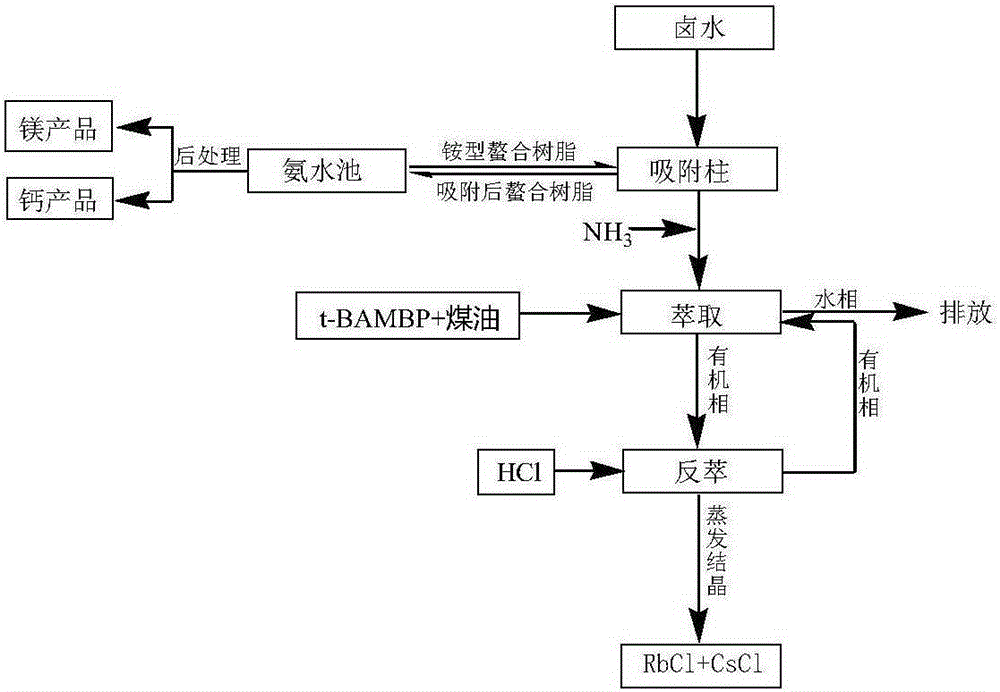Method for extracting rubdium and cesium from acid brine
A brine, rubidium-cesium technology, applied in the field of extracting rubidium-cesium, can solve problems such as unreported technical solutions, lack of brine pre-treatment process, great adsorption and separation interference, low production cost, easy solid-liquid separation, The effect of improving extraction efficiency
- Summary
- Abstract
- Description
- Claims
- Application Information
AI Technical Summary
Problems solved by technology
Method used
Image
Examples
Embodiment 1
[0028] see figure 1 , at 25°C, the initial concentrations of rubidium, cesium, sodium, potassium, calcium, and magnesium ions in brine were 19.0mg / L, 2.0mg / L, 30.55g / L, 20.60g / L, 23.84g / L, and 28.38 g / L, take 50g of ammonium-type chelating resin and pack it into the column, pump 100mL of simulated brine into the adsorption column, and transfer it to the ammonia water pool for transformation after the resin is saturated, wash away the residual ammonia on the surface and reload it into the adsorption column, and wait for After removing calcium and magnesium, add ammonia water to make the pH of the effluent liquid 11, then mix it with 100 mL of 1mol / L t-BAMBP sulfonated kerosene solution and enter the extraction device to vibrate for 10 minutes, after standing for 5 minutes, the oil and water are separated, and the water phase is discharged for subsequent salt extraction treatment. The organic phase enters the stripping device, add 80mL of 2.0mol / L HCl to shake for 10min, let sta...
Embodiment 2
[0030] At 25°C, the initial concentrations of rubidium, cesium, sodium, potassium, calcium, and magnesium ions in brine are 19.0mg / L, 2.0mg / L, 30.55g / L, 20.60g / L, 23.84g / L, and 28.38g, respectively / L, take 50g of ammonium-type chelating resin and pack it into the column, pump 100mL of simulated brine into the adsorption column, transfer it to the ammonia water pool for transformation after the resin is saturated, wash off the residual ammonia on the surface and reload it into the adsorption column, wait for the calcium After removing magnesium, add ammonia water to make the pH of the effluent liquid 11, then mix it with 100 mL of 1mol / L t-BAMBP sulfonated kerosene solution and enter the extraction device to vibrate for 5 minutes. phase into the stripping device, add 80mL of 2.0mol / L HCl to shake for 10min, let stand for 5min to separate oil and water, pump the organic phase into the extraction device for recycling, evaporate and crystallize the water phase on the heating plate...
Embodiment 3
[0032] At 25°C, the initial concentrations of rubidium, cesium, sodium, potassium, calcium, and magnesium ions in brine are 19.0mg / L, 2.0mg / L, 30.55g / L, 20.60g / L, 23.84g / L, and 28.38g, respectively / L, take 50g of ammonium-type chelating resin and pack it into the column, pump 100mL of simulated brine into the adsorption column, transfer it to the ammonia water pool for transformation after the resin is saturated, wash off the residual ammonia on the surface and reload it into the adsorption column, wait for the calcium After removing magnesium, add ammonia water to make the pH of the effluent liquid 11, then mix it with 100 mL of 1mol / L t-BAMBP sulfonated kerosene solution and enter the extraction device to vibrate for 10 minutes, after standing for 5 minutes, the oil and water are separated, and the water phase is discharged for subsequent salt extraction treatment, organic phase into the stripping device, add 80mL of 2.0mol / L HCl to shake for 5min, stand for 5min for oil-wat...
PUM
 Login to View More
Login to View More Abstract
Description
Claims
Application Information
 Login to View More
Login to View More - R&D
- Intellectual Property
- Life Sciences
- Materials
- Tech Scout
- Unparalleled Data Quality
- Higher Quality Content
- 60% Fewer Hallucinations
Browse by: Latest US Patents, China's latest patents, Technical Efficacy Thesaurus, Application Domain, Technology Topic, Popular Technical Reports.
© 2025 PatSnap. All rights reserved.Legal|Privacy policy|Modern Slavery Act Transparency Statement|Sitemap|About US| Contact US: help@patsnap.com

